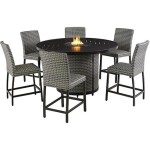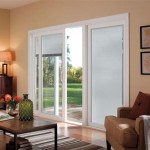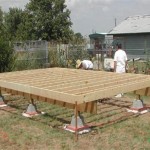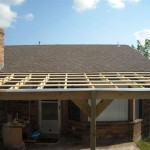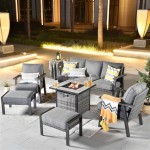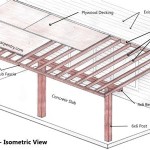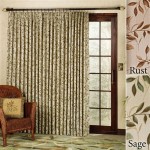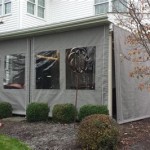Covered Patio Designs: Enhancing Outdoor Living Spaces
A covered patio represents a significant enhancement to any home, transforming a simple outdoor area into a versatile extension of the living space. The design possibilities are vast, influenced by architectural style, budget, intended use, and regional climate. Careful planning and consideration of various elements are essential to create a covered patio that is both aesthetically pleasing and functionally effective.
The primary function of a covered patio is to provide protection from the elements, shielding occupants from sun, rain, and sometimes even snow. This allows for year-round enjoyment of the outdoors, expanding the usable living area beyond the confines of the interior walls. Beyond mere protection, a well-designed covered patio can significantly increase a home's value and curb appeal. The seamless integration of the patio with the existing structure is critical for achieving a cohesive and visually appealing result. Factors like material selection, roof style, and structural integrity all contribute to the overall success of the design.
Choosing the Right Roof Style
The roof is arguably the most defining feature of a covered patio, dictating its overall appearance and influencing its functionality. Several roof styles are commonly employed, each with its own advantages and disadvantages.
A gable roof, characterized by its triangular shape and two sloping sides meeting at a ridge, is a popular choice due to its simplicity and cost-effectiveness. It provides excellent drainage, preventing water accumulation and minimizing the risk of leaks. The pitched design also allows for ample headroom, creating a more spacious and comfortable environment. Gable roofs can be easily integrated with various architectural styles, making them a versatile option for many homes.
A shed roof, also known as a skillion roof, features a single sloping plane. This design is often chosen for its modern aesthetic and ease of construction. Shed roofs are particularly well-suited for patios attached to homes with a contemporary design. They effectively deflect water away from the house and can be angled to optimize sunlight exposure or provide shade, depending on the specific needs of the homeowner.
A flat roof, while not entirely flat (it incorporates a slight slope for drainage), offers a clean, minimalist look. Flat roofs are often constructed using durable, waterproof materials such as modified bitumen or TPO. They can be a suitable option for patios where height restrictions are a concern or when a simpler, less obtrusive design is preferred. However, proper drainage is crucial to prevent water damage and ensure the longevity of the roof.
A pergola offers a different approach to covered patio design. Instead of a solid roof, a pergola consists of a framework of beams and rafters, providing partial shade and allowing for air circulation. Pergolas can be constructed from wood, metal, or composite materials, and they can be customized with climbing plants to create a natural and visually appealing aesthetic. While pergolas do not offer complete protection from the elements, they provide a comfortable and inviting outdoor space.
A retractable awning provides flexibility in controlling sunlight and shade. These awnings can be manually or automatically extended and retracted, allowing homeowners to adjust the level of protection based on weather conditions and personal preferences. Retractable awnings are available in a variety of colors and materials, and they can be easily installed on existing patios. However, they may not be as durable as permanent roof structures and may require more maintenance.
Material Selection and Durability
The materials used in the construction of a covered patio significantly impact its durability, aesthetics, and maintenance requirements. Choosing the right materials is essential for ensuring a long-lasting and visually appealing structure.
Wood is a classic choice for covered patios, offering a warm and natural aesthetic. Popular wood species include cedar, redwood, and pressure-treated pine. Cedar and redwood are naturally resistant to decay and insects, making them ideal for outdoor use. Pressure-treated pine is more affordable but requires regular maintenance to prevent rot and insect infestation. Wood patios can be stained or painted to match the existing house and can be customized with various design details. However, wood is susceptible to weathering and requires periodic sealing or painting to maintain its appearance and structural integrity.
Metal, such as aluminum or steel, offers a durable and low-maintenance alternative to wood. Aluminum is lightweight, rust-resistant, and can be easily formed into various shapes. Steel is stronger than aluminum but is susceptible to rust if not properly treated. Metal patios typically have a more modern aesthetic and can be powder-coated in a variety of colors. They are resistant to fire, insects, and decay, making them a long-lasting option. However, metal can be more expensive than wood and may not provide the same warmth and natural look.
Composite materials, such as those made from recycled plastic and wood fibers, offer a blend of durability and low maintenance. These materials are resistant to rot, insects, and weathering, making them ideal for outdoor use. Composite patios are available in a variety of colors and textures, and they can mimic the look of natural wood. They require minimal maintenance and are a sustainable choice. However, composite materials can be more expensive than wood and may not have the same natural appeal.
The roofing material should also match the style of the house. Asphalt shingles, tile, metal, or even polycarbonate panels are options depending on the roof style. Considering the weight and load-bearing capacity of the patio structure is also important when selecting roofing materials.
Creating an Integrated and Functional Space
A successful covered patio design goes beyond simply providing shelter; it creates an integrated and functional outdoor living space that seamlessly blends with the existing home. Consideration should be given to the layout, lighting, furniture, and accessories to create a comfortable and inviting environment.
The layout of the covered patio should be carefully planned to accommodate the intended use of the space. If the patio is primarily used for dining, a comfortable dining table and chairs should be placed in a central location. If the patio is intended for relaxation, comfortable seating options such as sofas, lounge chairs, and hammocks should be incorporated. The layout should also consider traffic flow and ensure that there is ample space for movement.
Proper lighting is essential for creating a welcoming and functional outdoor space. Ambient lighting, such as string lights or lanterns, can create a warm and inviting atmosphere. Task lighting, such as spotlights or recessed lights, can be used to illuminate specific areas, such as a dining table or outdoor kitchen. Accent lighting can be used to highlight architectural features or landscaping. The lighting should be strategically placed to enhance the overall ambiance and functionality of the patio.
Furnishing the covered patio with comfortable and durable outdoor furniture is crucial for creating a relaxing and inviting space. Choose furniture that is weather-resistant and easy to clean. Consider incorporating outdoor rugs, cushions, and throws to add warmth and texture to the space. Personalize the patio with accessories such as planters, artwork, and decorative items.
Integrating the covered patio with the surrounding landscape can enhance its beauty and functionality. Add plants, flowers, and shrubs to create a natural and inviting environment. Consider incorporating a water feature, such as a fountain or pond, to add a sense of tranquility. The landscaping should complement the architectural style of the patio and the existing home.
Finally, consider adding amenities that enhance the functionality of the covered patio, such as an outdoor kitchen, a fireplace, or a television. An outdoor kitchen can be equipped with a grill, sink, and refrigerator, allowing for outdoor cooking and entertaining. A fireplace can provide warmth and ambiance on cool evenings. A television can be used for outdoor movie nights or sporting events. The amenities should be carefully chosen to suit the specific needs and lifestyle of the homeowner.
In addition to these key considerations, it's crucial to consult with qualified professionals during the design and construction process. Architects, contractors, and landscape designers can provide valuable expertise and ensure that the covered patio is structurally sound, aesthetically pleasing, and compliant with local building codes. This collaborative approach helps to create a covered patio that maximizes enjoyment and adds lasting value to the home.

310 Best Outdoor Covered Patios Ideas In 2024 Backyard Patio

50 Best Patio Design Ideas For Outdoor And Backyard In 2024 Foyr

4 Of The Best Covered Patio Ideas For Pacific Northwest Homes Greenhaven Landscapes

6 Best Covered Patio Designs You Ll Fall In Love With Cricket Pavers

Dallas Outdoor Design What S Better Pergolas Or Covered Patios

12 Covered Deck Ideas That Will Elevate Your Outdoor Space

50 Patio Ideas For The Backyard Of Your Dreams

Pretty Covered Patios Patio Design Budget

10 Outdoor Patio Ideas To Inspire Your Next Project Drake S 7 Dees

50 Breathtaking Patio Designs For Backyards This Summer

